
Hornbeams are hardwood trees in the plant genus Carpinus in the family Betulaceae. Its species occur across much of the temperate regions of the Northern Hemisphere.

Platycladus is a monotypic genus of evergreen coniferous trees in the cypress family Cupressaceae, containing only one species, Platycladus orientalis, also known as Chinese thuja, Oriental arborvitae, Chinese arborvitae, biota or Oriental thuja. It is native to northeastern parts of East Asia and North Asia, but is also now naturalised as an introduced species in other regions of the Asian continent.
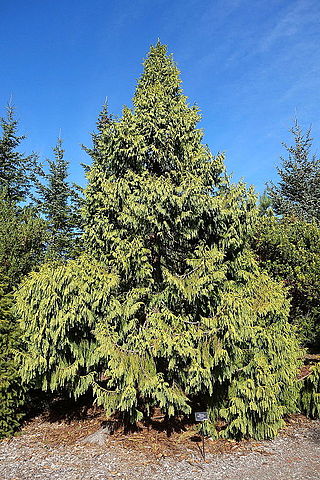
Taiwania, with the single living species Taiwania cryptomerioides, is a large coniferous tree in the cypress family Cupressaceae.

Carpinus betulus, the European or common hornbeam, is a species of tree in the birch family Betulaceae, native to Western Asia and central, eastern, and southern Europe, including southern England. It requires a warm climate for good growth, and occurs only at elevations up to 1,000 metres (3,281 ft). It grows in mixed stands with oak, and in some areas beech, and is also a common tree in scree forests. Hornbeam was also known as yoke elm.

Microbiota is a monotypic genus of evergreen coniferous shrubs in the cypress family Cupressaceae, containing only one species, Microbiota decussata. The plant is native and endemic to a limited area of the Sikhote-Alin mountains in Primorskiy Krai in the Russian Far East. Microbiota is not to be confused with the range of microorganisms of the same name. The genus name was derived from micro-, meaning "small", + Biota, the genus name for a closely related conifer, a species formerly called Biota orientalis, now renamed Platycladus orientalis.

Carpinus caroliniana, the American hornbeam, is a small hardwood understory tree in the genus Carpinus. American hornbeam is also known as blue-beech, ironwood, musclewood and muscle beech. It is native to eastern North America, from Minnesota and southern Ontario east to Maine, and south to eastern Texas and northern Florida. It also grows in Canada. It occurs naturally in shaded areas with moist soil, particularly near the banks of streams or rivers, and is often a natural constituent understory species of the riverine and maritime forests of eastern temperate North America.

Ostrya virginiana, the American hophornbeam, is a species of Ostrya native to eastern North America, from Nova Scotia west to southern Manitoba and eastern Wyoming, southeast to northern Florida and southwest to eastern Texas. Populations from Mexico and Central America are also regarded as the same species, although some authors prefer to separate them as a distinct species, Ostrya guatemalensis. Other names include eastern hophornbeam, hardhack, ironwood, and leverwood.

Cupressus torulosa, commonly known as the Himalayan cypress or Bhutan cypress, is a species of cypress tree native to the mountainous northern regions of the Indian subcontinent, in the western Himalayas.

Carpinus putoensis is a species of plant in the family Betulaceae. It is a small tree, up to 15 metres (49 ft) tall.
Platanthera calceoliformis is a species of orchid endemic to north-western Yunnan province, China. It is found at elevations of 3,200–4,000 metres (10,500–13,100 ft) in alpine grasslands. It is listed as an endangered species on the IUCN Red List.
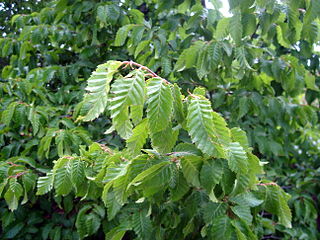
Carpinus orientalis, known as the Oriental hornbeam, is a hornbeam native to Hungary, the Balkans, Italy, Crimea, Turkey, Iran, and the Caucasus. and occurs usually on hot dry sites at lower altitudes in comparison to the Carpinus betulus.

Tabernaemontana pandacaqui, known as windmill bush and banana bush, is a species of plant in the dogbane family Apocynaceae.

Hypericum przewalskii, commonly called Przewalski's St. John's wort, is a flowering plant in Hypericumsect. Roscyna that is native to China.
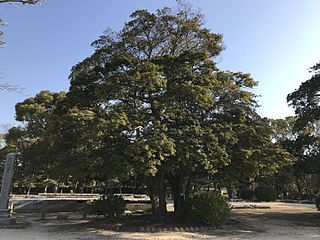
Machilus thunbergii, the Japanese bay tree, red machilus, or tabunoki, is a widespread species of flowering plant in the family Lauraceae. It is native to Vietnam, Taiwan, southeast and north-central China, the Korean Peninsula, and Japan. A sturdy evergreen tree, usually 10–15 m (30–50 ft) tall, and reaching 20 m (70 ft), it is used for timber, and as a street tree. Its bark is the source of makko, a powder used to make a mosquito‑repelling incense. It prefers coastal areas, and can handle saline soil.
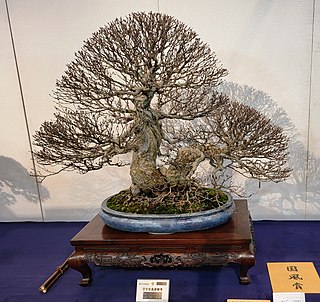
Carpinus turczaninovii, the Turczaninow hornbeam or Korean hornbeam, is a species of flowering plant in the family Betulaceae, native to central China, the Korean Peninsula, and central and southern Japan. It is a large shrub or small tree typically 15 to 20 ft tall and about 75% as wide, and is hardy to USDA zone 5b. It is available from commercial suppliers, and can handle very hard pruning.
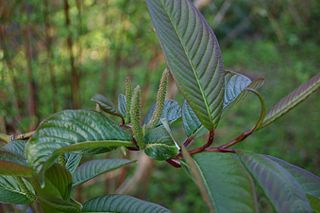
Salix moupinensis, the Moupin willow, is a species of flowering plant in the family Salicaceae, native to western Sichuan and northern Yunnan, China. It resembles Salix fargesii and is available from commercial suppliers.

Carpinus laxiflora, the aka-shide, loose-flower hornbeam, or loose-flowered hornbeam, is a species of flowering plant in the family Betulaceae, native to the Korean Peninsula, and Japan. A deciduous tree of mountain forests, and typically 10 to 15 m tall, it is used in bonsai, and rarely as a park or street tree. It is available from commercial suppliers. In addition to the rather rustic unimproved species, a weeping form called 'Pendula', and a sport with variegated leaves called 'Variegata' are available.
Carpinus hebestroma is a species of flowering plant in the family Betulaceae, native to Taiwan. A tree reaching 8 m (26 ft), it is found growing on forest slopes at elevations from 1,000 to 1,500 m. Found in only one location in Hualien County, it is assessed as Critically Endangered due to repeated monsoon-induced landslides.
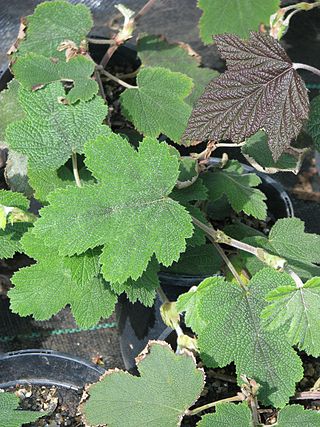
Rubus formosensis, the Formosan raspberry or Formosan bramble, is a species of flowering plant in the family Rosaceae, native to southeastern China, and Taiwan. It is found at a wide range of elevations, generally in habitats that have limited competition from other plants. A thornless shrub with a restrained climbing habit, reaching at most 2 m (7 ft), and with attractive evergreen leaves, it is available from commercial suppliers.

Carpinus kawakamii is a species of flowering plant in the hornbeam genus Carpinus . It is native to southeastern China, and Taiwan. A tree reaching 9 m (30 ft), it prefers to grow in sunny openings within forests at elevations from 500 to 2,000 m. It is available from specialist nurseries.



















